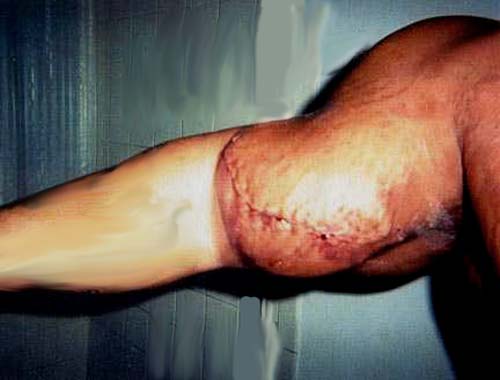Anabolic Steroid Abuse

Published: 18 Jun 2025
ICD9: V58.65 ICD10: Z79.51 ICD11: 6C4H.1Z
Anabolic steroid abuse refers to the misuse of anabolic-androgenic steroids (AAS) to enhance athletic performance, physical appearance, or for other non-medical reasons.
It's using these drugs outside of legitimate medical prescriptions and often involves higher doses and longer durations than medically prescribed.
Here's a breakdown of the key aspects:
![]() Anabolic-Androgenic Steroids (AAS): These are synthetic variations of the male hormone testosterone. "Anabolic" refers to muscle-building effects, and "androgenic" refers to the development of male characteristics.
Anabolic-Androgenic Steroids (AAS): These are synthetic variations of the male hormone testosterone. "Anabolic" refers to muscle-building effects, and "androgenic" refers to the development of male characteristics.
![]() Abuse: The core of the issue. This means:
Abuse: The core of the issue. This means:![]()

![]() Use without a valid medical prescription: AAS are legitimate medications for treating certain medical conditions, such as delayed puberty, hypogonadism (low testosterone), and muscle-wasting diseases. Using them without a doctor's authorization is abuse.
Use without a valid medical prescription: AAS are legitimate medications for treating certain medical conditions, such as delayed puberty, hypogonadism (low testosterone), and muscle-wasting diseases. Using them without a doctor's authorization is abuse.![]()

![]() Using dosages higher than medically prescribed: Even with a prescription, exceeding the recommended dosage or frequency constitutes abuse.
Using dosages higher than medically prescribed: Even with a prescription, exceeding the recommended dosage or frequency constitutes abuse.![]()

![]() Using AAS for non-medical reasons: Primarily to enhance athletic performance, increase muscle mass and strength, or improve physical appearance.
Using AAS for non-medical reasons: Primarily to enhance athletic performance, increase muscle mass and strength, or improve physical appearance.![]()

![]() Stacking: Combining multiple types of steroids to maximize their effects. This significantly increases the risk of side effects.
Stacking: Combining multiple types of steroids to maximize their effects. This significantly increases the risk of side effects.![]()

![]() Cycling: Taking steroids in cycles (periods of use followed by periods of abstinence) in an attempt to minimize side effects and maintain the gains. The effectiveness of cycling in preventing side effects is debated and often overstated.
Cycling: Taking steroids in cycles (periods of use followed by periods of abstinence) in an attempt to minimize side effects and maintain the gains. The effectiveness of cycling in preventing side effects is debated and often overstated.
![]() Motivations for Abuse:
Motivations for Abuse:![]()

![]() Athletic Performance: To gain a competitive edge in sports. AAS can increase muscle size, strength, and endurance.
Athletic Performance: To gain a competitive edge in sports. AAS can increase muscle size, strength, and endurance.![]()

![]() Body Image: To achieve a desired physique, often driven by societal pressures or personal insecurities.
Body Image: To achieve a desired physique, often driven by societal pressures or personal insecurities.![]()

![]() Social Pressure: Sometimes, people may feel pressure to use steroids from peers or within their social groups.
Social Pressure: Sometimes, people may feel pressure to use steroids from peers or within their social groups.
![]() Health Risks: Anabolic steroid abuse is associated with a wide range of serious health risks, including:
Health Risks: Anabolic steroid abuse is associated with a wide range of serious health risks, including:![]()

![]() Cardiovascular Problems: High blood pressure, increased cholesterol levels, heart attack, stroke, and heart enlargement (cardiomyopathy).
Cardiovascular Problems: High blood pressure, increased cholesterol levels, heart attack, stroke, and heart enlargement (cardiomyopathy).![]()

![]() Liver Damage: Liver tumors, cysts, and impaired liver function.
Liver Damage: Liver tumors, cysts, and impaired liver function.![]()

![]() Hormonal Imbalances: Gynecomastia (breast enlargement in men), testicular shrinkage, decreased sperm production, infertility, menstrual irregularities in women, deepening of the voice in women, clitoral enlargement in women, and male pattern baldness in both sexes.
Hormonal Imbalances: Gynecomastia (breast enlargement in men), testicular shrinkage, decreased sperm production, infertility, menstrual irregularities in women, deepening of the voice in women, clitoral enlargement in women, and male pattern baldness in both sexes.![]()

![]() Psychiatric Effects: Aggression ("roid rage"), mood swings, depression, anxiety, paranoia, and hallucinations.
Psychiatric Effects: Aggression ("roid rage"), mood swings, depression, anxiety, paranoia, and hallucinations.![]()

![]() Musculoskeletal Problems: Premature closure of growth plates in adolescents, leading to stunted growth; increased risk of tendon injuries.
Musculoskeletal Problems: Premature closure of growth plates in adolescents, leading to stunted growth; increased risk of tendon injuries.![]()

![]() Skin Problems: Acne, oily skin, and fluid retention.
Skin Problems: Acne, oily skin, and fluid retention.![]()

![]() Infections: If steroids are injected, there is a risk of HIV, hepatitis, or bacterial infections from sharing needles.
Infections: If steroids are injected, there is a risk of HIV, hepatitis, or bacterial infections from sharing needles.![]()

![]() Withdrawal Symptoms: When steroid use is stopped, users can experience withdrawal symptoms such as fatigue, depression, loss of appetite, insomnia, and decreased sex drive.
Withdrawal Symptoms: When steroid use is stopped, users can experience withdrawal symptoms such as fatigue, depression, loss of appetite, insomnia, and decreased sex drive.
![]() Legality: In many countries, including the United States, anabolic steroids are classified as controlled substances, and their possession or sale without a valid prescription is illegal.
Legality: In many countries, including the United States, anabolic steroids are classified as controlled substances, and their possession or sale without a valid prescription is illegal.
In summary, anabolic steroid abuse is the non-medical use of these drugs to enhance performance or appearance, often at high doses or in combination with other substances, leading to significant health risks and potential legal consequences. It's important to understand that these drugs have serious side effects and should only be used under the strict supervision of a qualified medical professional for legitimate medical purposes.